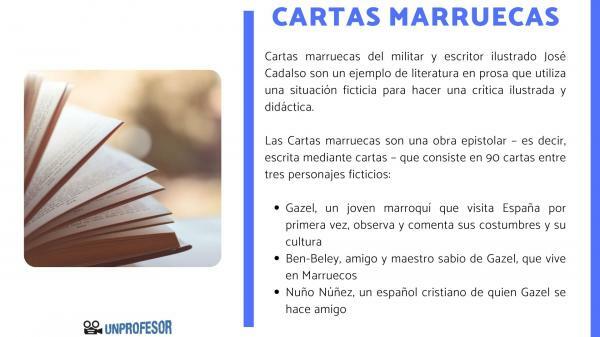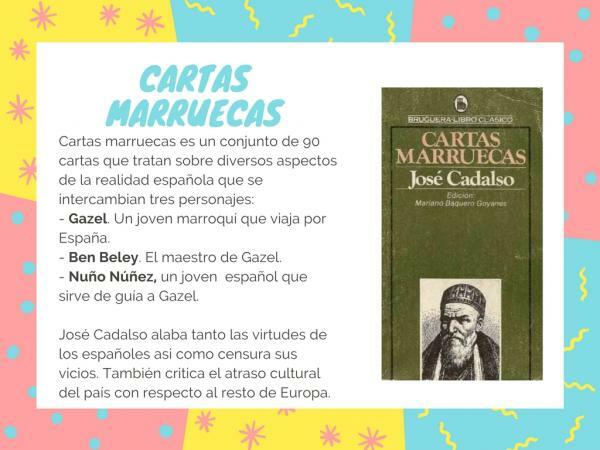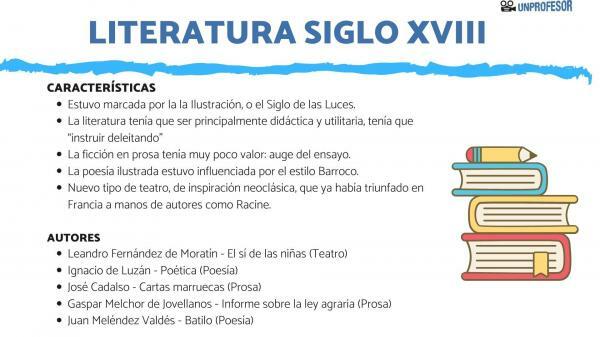MOROCCO LETTERS summary and text comment

The 18th century is also called the Century of the lights, wave Illustration, in European literature. This does not refer to an alleged literal light pollution, but in the light of reason, that is, to the knowledge and critical thinking as the center of both society and politics, as well as literature. The arts had to "instruct by delighting": transmitting a didactic message for the public to learn or reflect on various topics while entertaining themselves.
This meant that prose fiction was not widely cultivated during the period. Fiction or lyric was written in verse, while prose was mostly used to write essays that spread the ideas of the Enlightenment. However, texts such as Moroccan letters of the military man and illustrated writer Jose Cadalso, are an example of Prose literature that uses a fictional situation to make an illustrated and didactic criticism.
In this lesson from a TEACHER we will do a summary of the Moroccan letters, and we will write a Text commentary of Letter XXI to analyze both his ideas and his instructive role. We started!
The Moroccan letters They're a epistolary work - that is, written by means of letters - which consists of 90 cards between three fictional characters: Gazel, a young Moroccan visiting Spain for the first time, observing and commenting on its customs and culture; Ben-Beley, Gazel's wise friend and teacher, who lives in Morocco; and Nuño Núñez, a Spanish Christian whom Gazel befriends.
The work was published posthumously in 1789, and is a perfect example of the features who dominated the illustrated literature 18th century. Among these we highlight:
- Epistolary writing (by letters)During the eighteenth century throughout Europe, prose fiction often took the epistolary form, since the genre of the novel was not highly regarded. As Cadalso himself writes in the introduction to the book, the epistolary method "makes its reading more comfortable, its distribution easier, and its style more enjoyable." The letters also allow Cadalso to present different points of view on the same issues.
- The writer (Cadalso in this case) presents himself as the mere editor of the work, and not as the author of it. This was a widely used resource at the time to give more credibility to the work and to demonstrate that the themes it addresses and the criticisms it presents were pertinent to real life.
- Reflection of the ideas of the Enlightenment. Illustrated literature had to serve to disseminate one's ideas to enlightened intellectuals. These were: domain of reason, critical thinking, empiricism, advances and importance of science, questioning of dogmas (including religion) and old customs, critical freedom, tolerance, diffusion of knowledge, demand for progress and reforms, etc.
- Use of the resource a foreign character or traveler commenting on the customs of Europeans, or vice versa, to portray European society in a critical way. This was a recurring resource in the literature of the time, used in works such as the Persian letters of Montesquieu (maximum inspiration of Cadalso), Gulliver's Travels by Jonathan Swift, The naive of Voltaire, or Bougainville trip supplement by Diderot, among others.
- Didactic function: Although the letters are not an actual correspondence, Cadalso's intention in writing them was not to tell an entertaining story. The use of fictitious letters is only an "excuse" to describe the absurdities and failures of the Spanish culture and society from an external point of view, and make us reflect on why and how we should improve them.

Image: Proeliteraria
We begin this Summary of the Moroccan letters introducing the moroccan Gazel who writes to his friend, the old man Ben-beley, from Spain, where he has arrived with the ambassador of his country. His intention is to stay there to "travel with utility", that is, to get into Spanish society and culture and observe its customs and curiosities from within. For this he has also established a relationship of friendship with the Christian Spaniard Nuño Nunez, with whom he intends to dialogue about his observations (Letter I).
From now on, Gazel, Nuño and Ben-Beley will share their opinions on different topics, writing to each other (mostly Gazel to Ben-Beley). The themes dealt with in the letters are varied and pertinent to the context of 18th century Spain and to enlightened concerns. Cadalso's will, as he expresses in his Introduction, is to reflect the "national character" of the country.
Themes of the Moroccan Cards
To do this, Moroccan Cards of Cadalso include themes such as the history of Spain, on which Gazel is informed through his friend Nuño (letters II, V, XVI, LVII, LIX ...), including a reflection on the need for objectivity and impartiality in the study of this (letter V), in the case of historical moments such as the conquest of Mexico.
Other topics include education (letter VII, XLII ...), class problems, and criticism of the nobility (XII, XIII ...). Cadalso criticizes the hereditary nobility through Gazel's confusion, and Nuño's taunts:
“Hereditary nobility is the vanity that I found in that, eight hundred years before my birth, I died one who was named as I am, and was a man of profit, although I am useless for everything "(letter XIII).
The patriotism It is also one of the main topics discussed in the Letters. The variety of perspectives of the characters allows Cadalso to describe both what he calls a "misunderstood patriotism" (letter XXI), and good patriotism embodied mainly by the figure of Nuño ("noble enthusiasm of patriotism" (LXII), according to the enlightened point of view, and what Cadalso as an intellectual of the Enlightenment considered virtue or vice.
Other topics include diversity in the different regions of Spain, but also the differences between Spaniards and Europeans, criticism of both the pre-baroque era as well as its contemporary eighteenth century, comments on the writers Spanish people, women (LXXV, LXXVI…), religion, and decadence.
The character of Nuño, patriotic but very critical of the country's situation and the need for a progress that he sees difficult, he writes a dictionary (letter VIII), allowing Cadalso to incorporate too reflections on the Spanish language (letter XXXVII, LI, LIV, LXIII ...), its evolution and the influence of other languages on it, as well as comments on the work of translation of texts, of great importance for the dissemination of illustrated ideas throughout Europe (letter XLIX, L).
In the last letter, Gazel announces the departure from Spain, and his desire to "enlighten [Ben-Beley], if he is still blind", or that "his heart from him, if he has already received this light, the communicate to mine, and united both, form greater clarity. " The Age of Enlightenment thus illuminates with the light of knowledge and critical thought all who are willing to hear it.
End of Moroccan Cards
Finally, Cadalso concludes his Moroccan Cards with a note and one "Literary protest of the editor of the Moroccan Cards”. In the first, Cadalso alludes to a continuation of the correspondence between the three characters, thus giving a more realistic feeling to the work.
In the second, Cadalso imagines the criticisms that the reader can make of his work and asks for the "charitable consideration of my pious, benevolent and reader friend." These words should not be read only as the author's insecurities, but as a veiled criticism of the present literary censorship. in the century, and from the society itself that would receive such a correspondence and the ideas expressed in it with indignation and offense.

Image: Proeliteraria
The text in question corresponds to the “Letter XXI" from Moroccan Cards, epistolary work written by José Cadalso, one of the main representatives of the Spanish Enlightenment in literature. In the context of the play, this letter is the first that appears written by the character of Nuño, Christian Spanish, whose critical point of view while remaining patriotic complements the observations of foreigners Gazel and Ben-Beley on the culture and customs of contemporary Spain Scaffold.
The letter is constructed as a response and based on the previous letter from Ben-Beley to Nuño. Along with this previous letter, Ben-Beley copies the correspondence that he has had so far with the young Gazel, and asks Nuño about contribute his own perspective on the vision of Spain reported so far, which has left the Moroccan sage confused and questioning.
In Letter XXI, Nuño denies the vision that Ben-Beley has obtained from Spain through Gazel, and describes the "Spanish character" through the individual, with "the same vices and virtues as his fifth grandparents." Nuño indicates that the defects of the Spanish (and therefore, of his nation) cannot be “annihilated” to replace them completely, but he does give examples of elements that are not typical of the country, although to some it seems that they are (the "old Spanish" costume, Aristotelian philosophy, or military discipline Spanish). According to him, adherence to these examples as part of a national character is absurd, and he calls it "misunderstood patriotism."
This first direct intervention by Nuño Núñez helps Cadalso to provide a deeper and more educated vision of the Spanish character than first impressions of a foreigner like Gazel. Although Nuño's voice had already appeared through Gazel's explanations in the letters prior to this one, "Letter XXI" establishes for the first time a direct dialogue of perspectives, and it is through Nuño's intervention in this letter that the truly illustrated text begins to be constructed through a multiple, diverse, critical vision based on the search for a “right balance”.
This idea of "Fair middle" is present throughout the entire letter. Not only does Nuño's contribution itself provide an opposite point from which to balance Gazel's vision towards a "right middle", but his arguments about the national character and patriotism They also defend the properly illustrated idea of qualifying the extremes to obtain a critical and reasoned conclusion:
At the beginning of the letter, Nuño affirms that "the nation is today the same as it was three centuries ago", that a country behaves like the individuals that make it up, with their vices and virtues that they build their identity for better or worse. It is not possible to pretend that a nation “remains with its own virtues alone and divests itself of its own defects to acquire in their place is the virtues of strangers ”, since both are part of“ their constitution ”and define it as it is.
However, Nuño continues his speech with a "However" that qualifies the idea that he has just transmitted. The examples that he gives below demonstrate that there may also be false “Spanish” characteristics that there is no point in defending or safeguarding. Patriotism can be positive (Nuño himself is described as a lover of his country in Letter III), but as long as it is not "misunderstood patriotism."
Nuño ends his letter with the perfect expression of the "right mean" and moderation:
“The very extreme economy is greed; excessive prudence, cowardice; and rash courage, recklessness. "
Nuño's vision of patriotism not only contributes to the idea of the "right middle" within the letter itself, but also in the set of the work, qualifying the idea expressed by Gazel in Letter XVI that "There is no patriotism", by example.
Another theme implicit in the letter is that of Spain, which has its own character that makes it different from other nations, and which does not necessarily have to be changed. One of the criticisms that were made mainly of the illustrated ones such as Cadalso was that of wanting to "Frenchize" Spain, and although it is true that many of the ideas of the Enlightenment came from European countries such as France, and that the Enlightenment promoted a Europeanization of the country in matters that they considered in decline and necessary for reform, Cadalso refutes in this letter the idea of wanting to "annihilate" the Spanish character ("what is part of its constitution") without renouncing to "work to reduce these and increase those" (good and bad properties).
The "Letter XXI" of Moroccan Cards thus begins the multiplicity of perspectives that defines the work of Cadalso and that serve to build an illustrated critique of his contemporary Spain. The concept of identity linked to the nation and patriotism is explored both for its character unique and immutable, as by the need to change what is absurd and necessary reform.
The idea of the nation is like a man, with its vices and virtues, raises the possibility that the enlightened man, with his desire to disseminate knowledge and critical thinking Through texts like this, he can contribute to the betterment and progress of a nation that is more like him.




